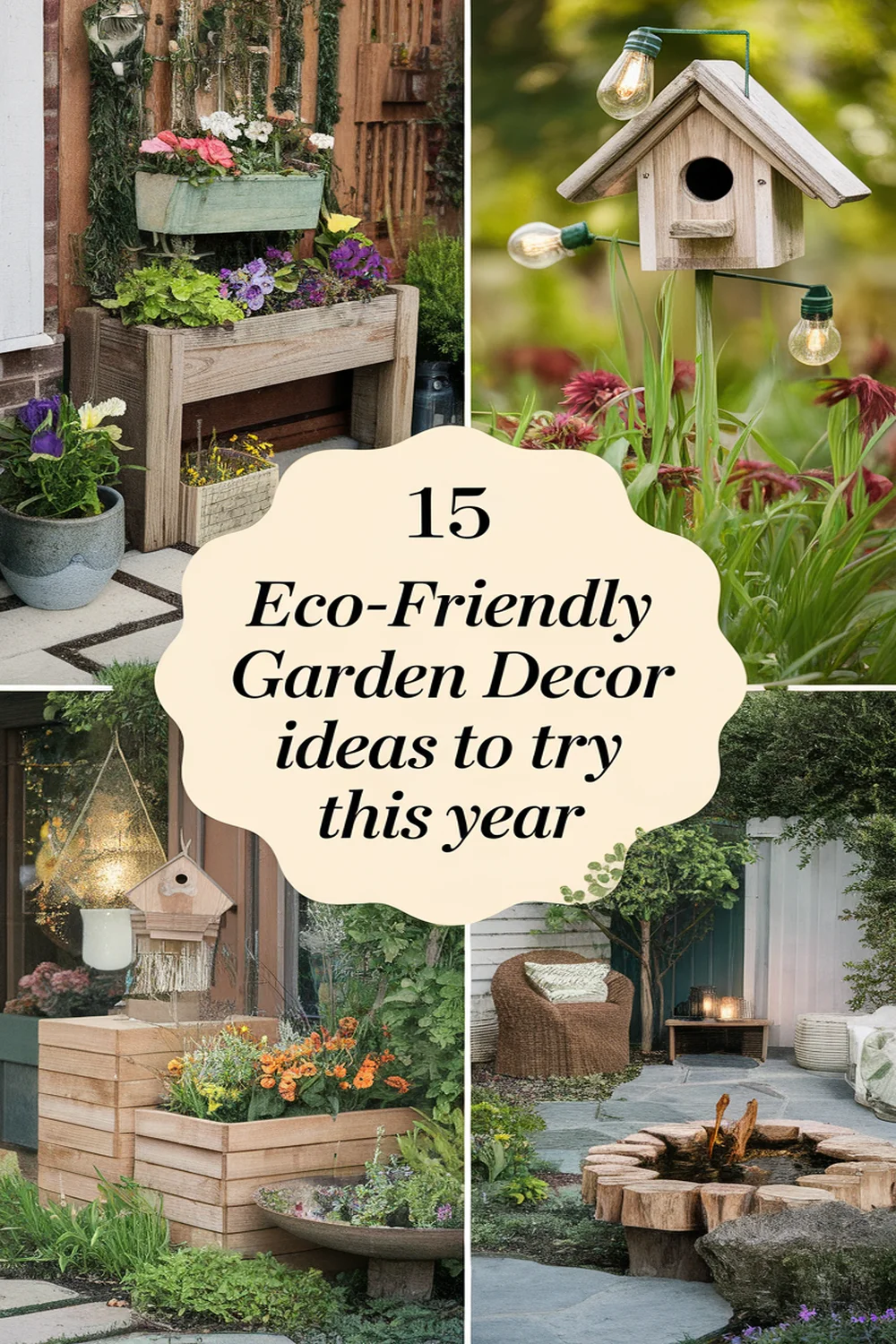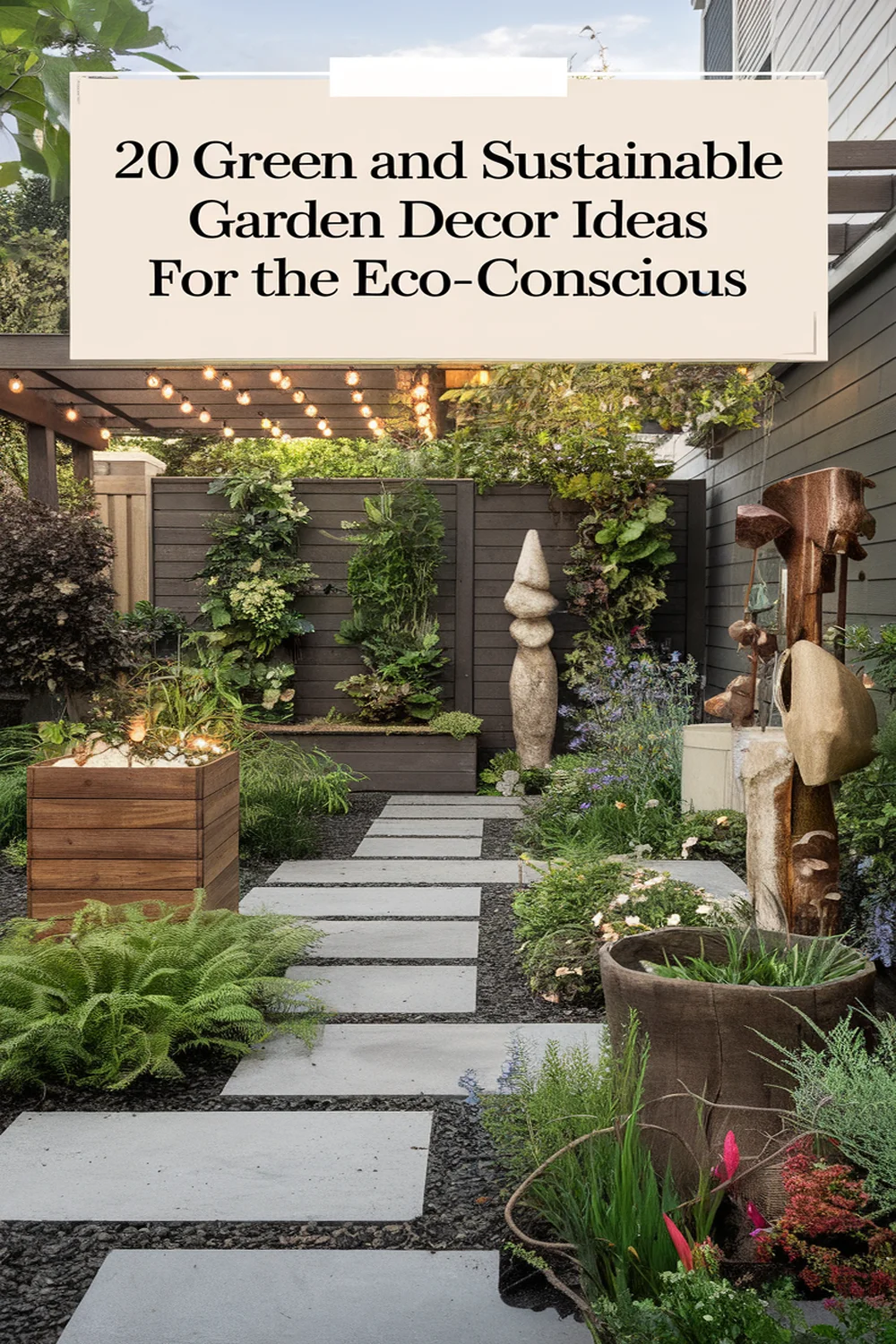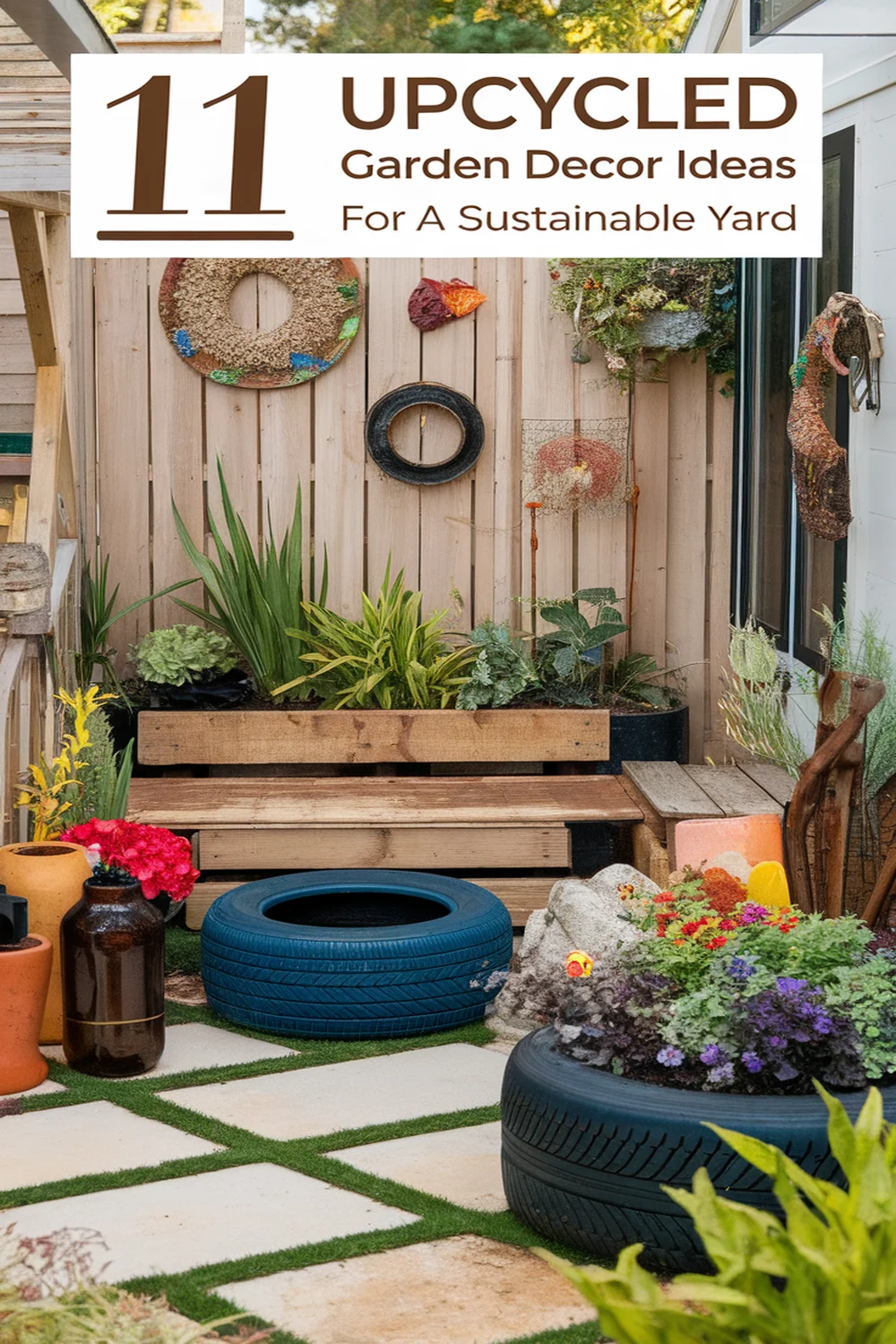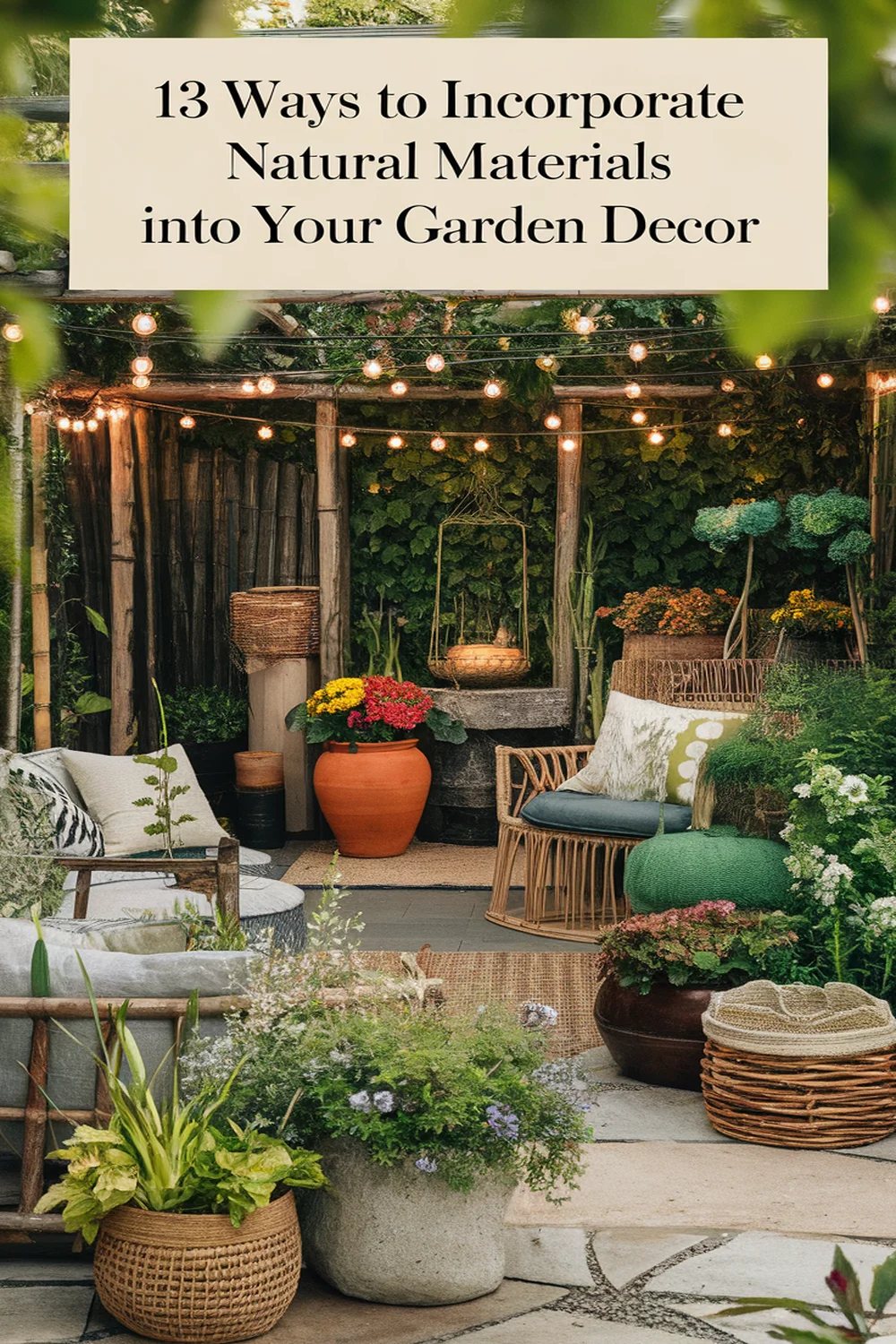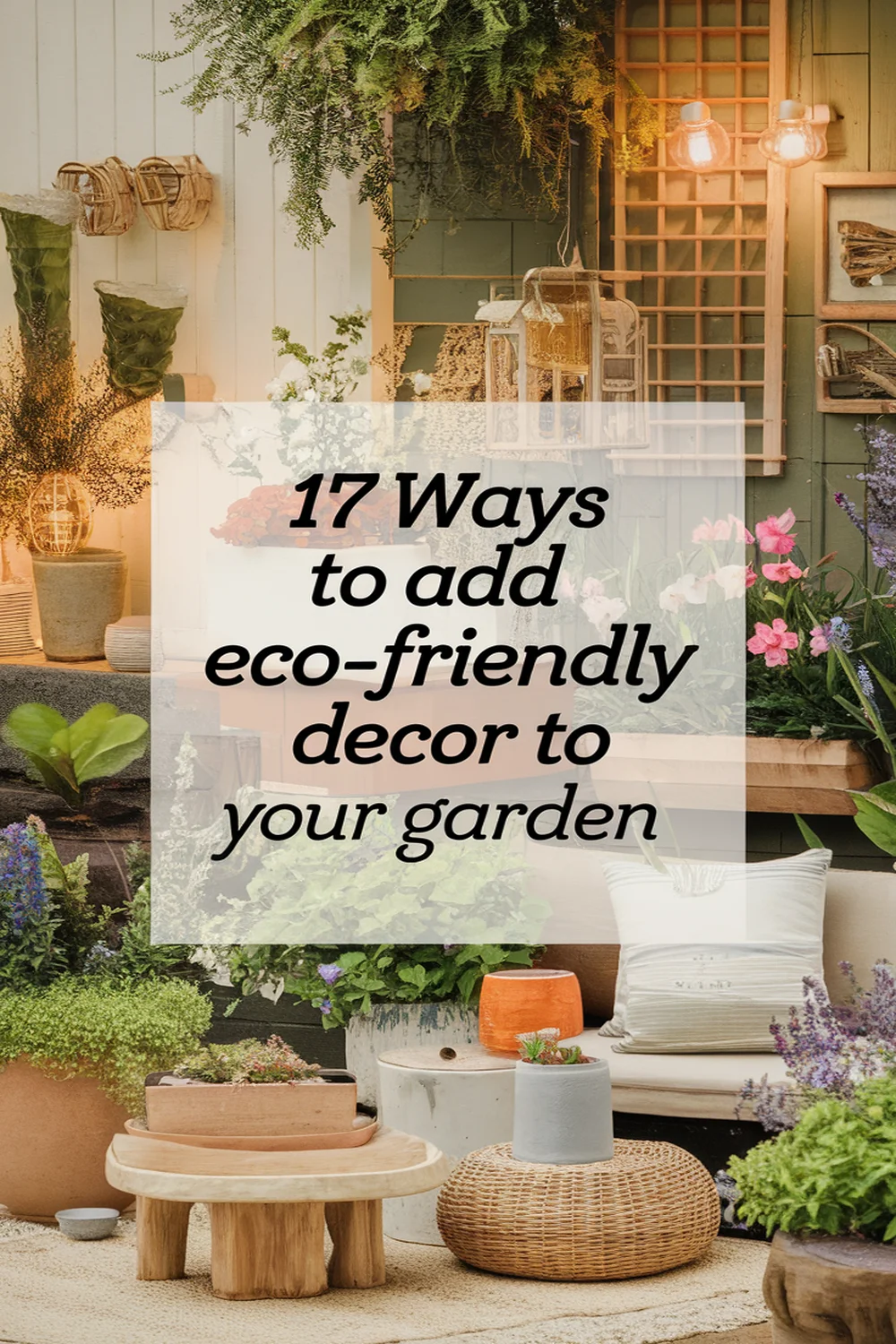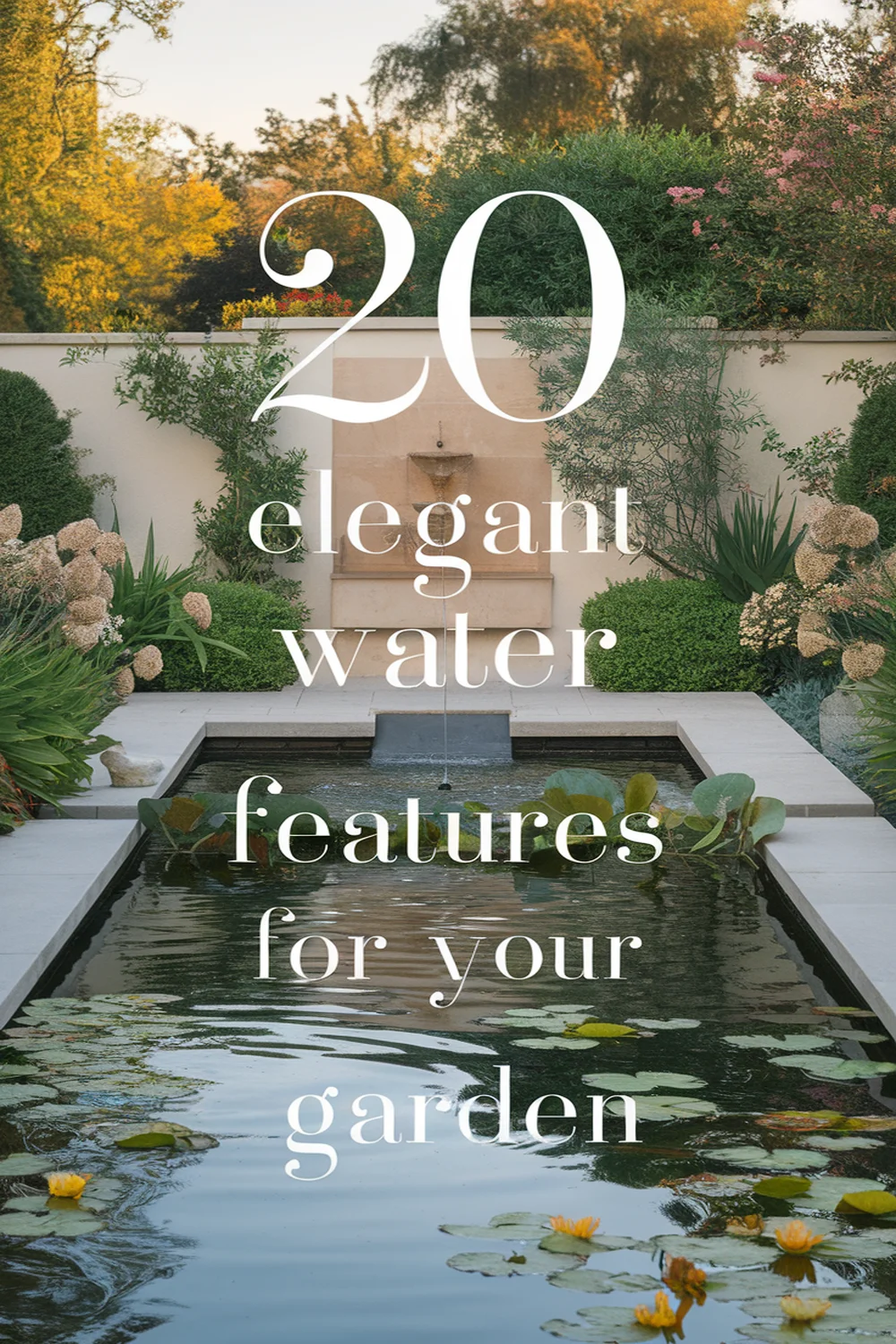This post may contain affiliate links. Please read our policy page.
Transform your outdoor space with eco-friendly decor ideas this year! Try upcycled furniture as charming plant stands or create lively birdhouses from reclaimed wood. Use recycled glass items for vibrant garden art, and consider compost bin planters to support healthy growth. Native plant landscaping attracts wildlife, while biodegradable planters promote sustainability. Embrace vertical gardens for tight spaces, and use living hedges for natural privacy. Exciting transformations await as you explore more innovative options for your garden!
Upcycled Furniture Transformations

Upcycled furniture transformations can breathe new life into your garden while promoting sustainability. Instead of tossing old chairs, tables, or dressers, you can creatively reimagine them for outdoor use. A weathered wooden chair can become a charming plant stand—simply sand it down, paint it with outdoor-safe paint, and arrange your favorite potted plants. An old dresser can serve as a unique vertical garden; you can remove drawers and utilize the space for planting herbs or flowers. Consider using colorful fabric or cushions to bring comfort to seating areas. By upcycling, you’re not only saving money but also minimizing waste, making your garden an eco-friendly haven that reflects your personal style. Embrace this creative challenge and watch your outdoor space flourish!
Recycled Glass Garden Art
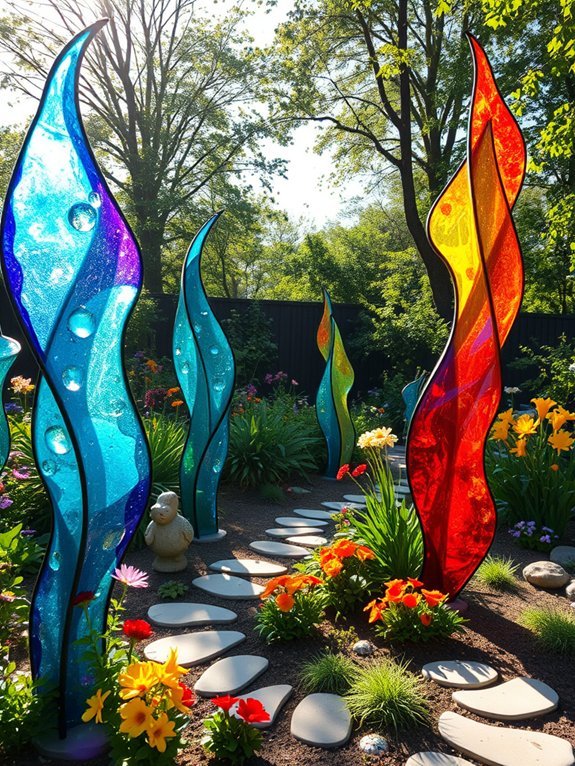
Recycled glass garden art adds a vibrant touch to your outdoor space while promoting eco-consciousness. You can create stunning decorative pieces using colorful glass bottles, jars, and plates. Start by gathering old glass items that would otherwise end up in landfills. You could paint or etch designs on them, turning these ordinary objects into eye-catching sculptures or garden stakes.
Additionally, consider making mosaic stepping stones with crushed glass or integrating glass in wind chimes for a musical addition to your garden. Not only will these projects showcase your creativity, but they’ll also inspire others to think sustainably. Embrace the beauty of recycled materials, and let your garden reflect both your style and commitment to the environment.
Compost Bin Planters

Transforming an old compost bin into a planter can give your garden a unique flair while promoting sustainability. Start by cleaning the bin thoroughly and ensuring it’s free from chemical residues. Next, choose your favorite plants—herbs or flowers work wonderfully. For drainage, drill some holes in the bottom if it’s solid. Fill it with a mix of high-quality potting soil and compost. As you plant, think about layering for visual interest; taller plants in the back and shorter ones in front work best. Don’t forget to position your planter in a spot that receives enough sunlight. This eco-friendly project not only repurposes materials but also adds character to your garden while supporting healthy plant growth. Happy planting!
Native Plant Landscaping

Incorporating native plants into your landscaping not only enhances the beauty of your garden but also supports local ecosystems. These plants are adapted to your region’s climate, require less water, and attract beneficial wildlife, like pollinators.
| Native Plant | Benefits |
|---|---|
| Black-eyed Susan | Attracts bees and butterflies |
| Coneflower | Drought-resistant and vibrant |
| Wild Bergamot | Great for attracting hummingbirds |
Recommended Items
Discover our curated selection of eco-friendly products and tools to enhance your garden—let’s get started!
DIY Birdhouses From Reclaimed Wood

Creating DIY birdhouses from reclaimed wood is a fantastic way to add charm to your garden while promoting sustainability. First, gather your materials—old pallets, discarded fence boards, or even wooden crates work well. Measure and cut the wood into the necessary pieces: a base, sides, top, and front with a hole for entrance. Use non-toxic screws or nails to assemble, ensuring the house is sturdy for its feathered residents.
Consider adding ventilation holes and drainage to keep your birdhouse functional. Paint it with eco-friendly paint or leave it natural to blend with your garden. Finally, place your birdhouse in a quiet, sheltered spot, and watch as it attracts vibrant birds, enhancing your outdoor experience. Enjoy your creation!
Step-by-Step Guide to Eco-Friendly Decor
Rainwater Harvesting Systems
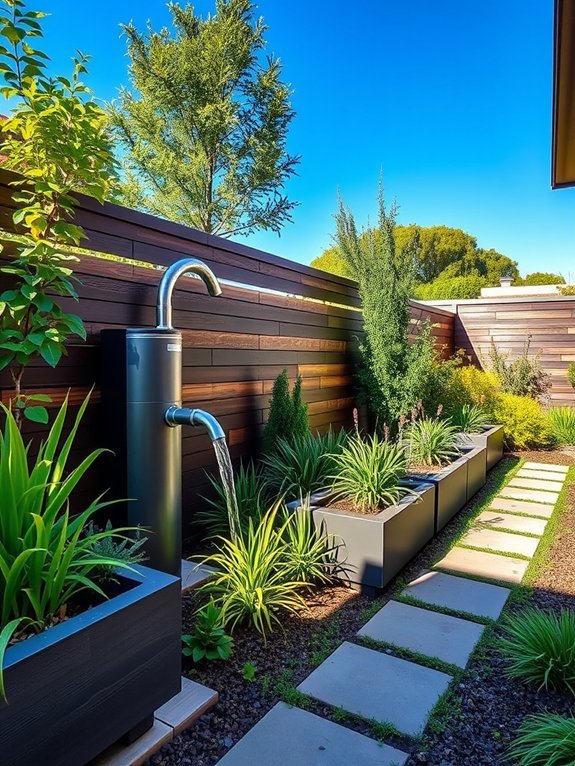
In addition to adding decorative birdhouses to your outdoor space, implementing a rainwater harvesting system can considerably boost your garden’s sustainability. Collecting rainwater isn’t just eco-friendly; it’s practical too. You can install a simple rain barrel beneath your downspouts to capture runoff. This stored water can be used for irrigation during dry spells, saving both money and resources.
Consider using a sturdy, food-grade container to guarantee water purity, and add a screen to keep debris and insects at bay. Set a spigot at the bottom for easy access. Plus, with a little creativity, you can decorate the barrel to fit your garden’s aesthetic! Taking this step not only conserves water but also enhances biodiversity in your backyard.
Solar-Powered Garden Lights
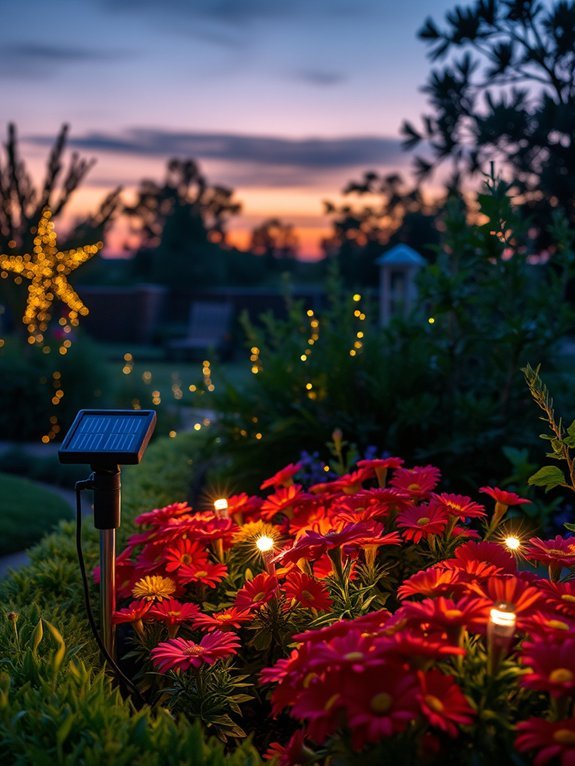
Solar-powered garden lights can transform your outdoor space into a magical evening retreat. By harnessing sunlight during the day, these eco-friendly lights illuminate your garden at night without adding to your electric bill. Here’s a quick comparison to help you choose the right type:
| Type | Brightness | Ideal Location |
|---|---|---|
| String Lights | Soft Glow | Patios & Decks |
| Spotlights | Bright | Pathways & Trees |
| Lanterns | Moderate | Tables & Benches |
| Path Lights | Low | Garden Walkways |
With so many styles available, you’ll easily find lights that complement your garden’s aesthetic and enhance its beauty. Embrace sustainability while enjoying a cozy ambiance!
Natural Stone Pathways

While you’re designing your garden, consider how natural stone pathways can enhance both its beauty and functionality. These pathways not only guide visitors through your outdoor space, but they also add a rustic charm that complements your plants. Choose stones that blend with your landscape—flagstone, slate, or even river stones work beautifully. You can create varying widths for added interest, and don’t be afraid to let moss or grass grow between the stones for a more organic look. Installing a path is straightforward; just clear the area, lay the stones, and fill in any gaps for stability. Plus, natural stones are durable and eco-friendly, making them a smart choice for sustainable gardening. Enjoy the harmony they bring to your garden!
Wildflower Meadows
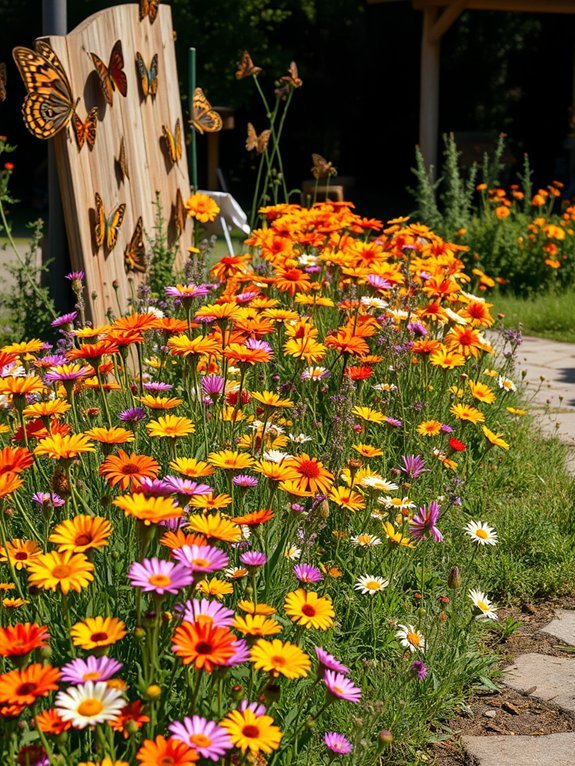
Creating a wildflower meadow can transform your garden into a vibrant ecosystem, attracting a variety of pollinators and providing a stunning visual display. To get started, select a sunny area that’s well-drained. Remove any existing grass and weeds, then loosen the soil for better seed-to-soil contact. Choose native wildflower seeds suited to your region; they’re more resilient and require less maintenance. Spread the seeds evenly and lightly rake them into the soil. Water gently until they establish, and limit mowing to preserve diverse growth. By allowing wildflowers to bloom freely, you’ll create a colorful landscape while supporting local wildlife. Plus, you won’t need harmful chemicals, making your garden a safe haven for all. Enjoy the beauty and benefits of your flourishing wildflower meadow!
Eco-Friendly Garden Mulch
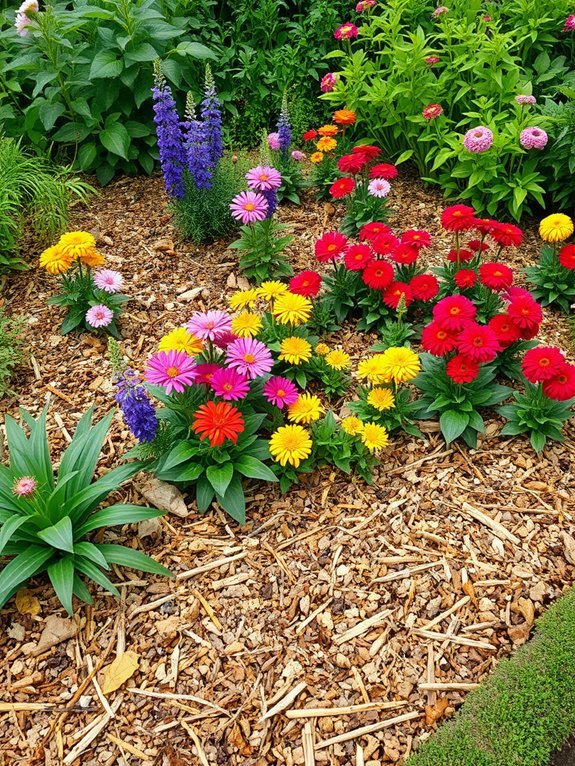
Mulching your garden not only enhances its appearance but also promotes healthier plants, so it’s important to choose eco-friendly options. A great mulch can retain moisture, suppress weeds, and improve soil health. Here are some sustainable materials you can use:
| Mulch Type | Benefits | Tips |
|---|---|---|
| Straw | Retains moisture and suppresses weeds | Use thick layers |
| Wood Chips | Breaks down slowly, adding organic matter | Choose untreated wood |
| Grass Clippings | Nutrient-rich and great for moisture retention | Dry before applying |
| Leaves | Improves soil texture as they decompose | Chop before spreading |
| Pine Needles | Acidic, perfect for acid-loving plants | Avoid thick mats |
Embrace these eco-friendly options to create a beautiful, thriving garden!
Herb Spiral Gardens
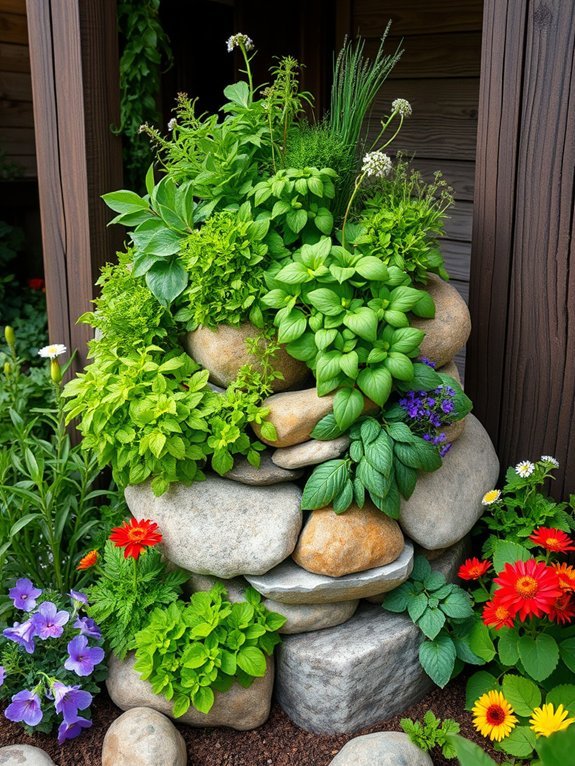
After establishing a sustainable foundation with eco-friendly mulch, you can elevate your garden’s functionality and charm by incorporating an herb spiral garden. This innovative design not only maximizes space but also creates microclimates ideal for various herbs. By stacking stones or soil, you’ll form a spiral that encourages drainage and sunlight exposure.
Start with the base, planting moisture-loving herbs like mint, and work your way up with drought-resistant varieties like rosemary. The tiered structure makes it easy to access your herbs, promoting an interactive gardening experience. Plus, you’ll beautify your space while providing fresh flavor for your meals. Herb spirals are perfect for small yards or patios, allowing you to enjoy a bountiful harvest in a compact footprint.
Biodegradable Planters
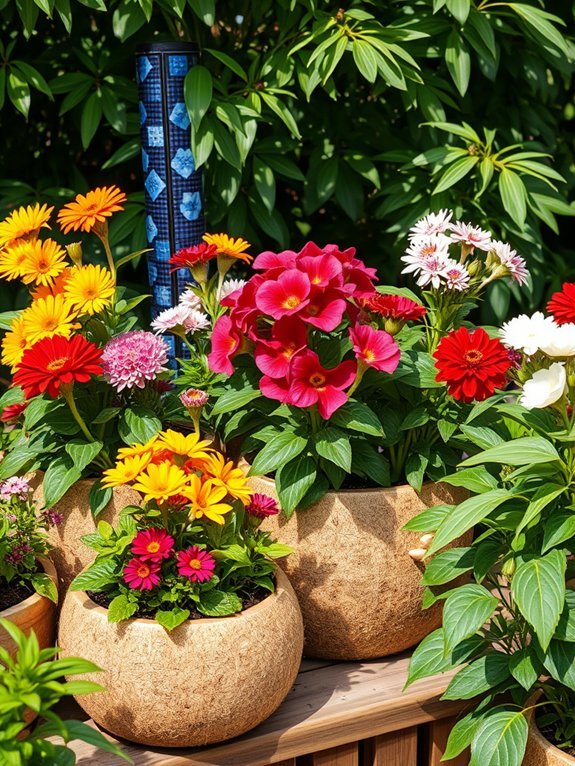
While you’re transforming your garden, consider using biodegradable planters that not only benefit your plants but also the environment. These planters break down naturally, reducing waste and enriching the soil. You’ll find several materials to choose from, each offering unique benefits.
Here are some popular options to explore:
- Coconut Coir: Great for aeration and moisture retention.
- Paper Pots: Lightweight and versatile, perfect for seedlings.
- Bamboo: Durable and stylish, adding a rustic touch to your garden.
- Compostable Bioplastics: Made from renewable resources, they decompose along with your plants.
Switching to biodegradable planters makes your gardening more sustainable and contributes to a healthier ecosystem. Enjoy your gardening journey, knowing you’re helping the planet!
Vertical Garden Solutions

Vertical gardens are a fantastic solution for maximizing space and adding lush greenery to your home or garden. You can transform small areas into vibrant, living displays by utilizing wall-mounted planters or trellises. Start by selecting sturdy plants that thrive vertically, such as succulents, herbs, or trailing vines.
Arrange your chosen plants in a strategic way, considering their sunlight and water needs. Use recycled materials like pallets or plastic bottles to create eco-friendly planters. Guarantee proper drainage to keep your plants healthy. Vertical gardens not only beautify your space but also improve air quality and provide insulation. With a little creativity and effort, you can create a stunning vertical garden that’s both practical and visually appealing.
Living Fences Using Hedges

Creating a living fence with hedges offers a natural solution for privacy and noise reduction while enhancing your landscape’s beauty. These lush barriers not only look great but also provide ecological benefits. Here’s how to make the most of your living fence:
- Choose Native Plants: Select local hedge varieties that thrive in your climate and require less water.
- Plan for Growth: Allow enough space for hedges to mature; this helps create a dense and effective barrier.
- Regular Maintenance: Prune and shape your hedges annually to keep them healthy and visually appealing.
- Add Variety: Consider mixing different species for texture, color, and interest throughout the seasons.
With a little effort, you can transform your outdoor space into a beautiful haven.
Eco-Conscious Garden Statues

Incorporating eco-conscious garden statues can elevate your outdoor space while showcasing your commitment to sustainability. Look for statues made from recycled materials, such as glass or metal, to minimize your environmental footprint. Consider options crafted from sustainably sourced wood or biodegradable materials that blend harmoniously with nature.
When selecting a statue, think about your garden’s theme. Whether it’s quirky, elegant, or whimsical, your choice should reflect your personal style. Smaller sculptures can add charm to flower beds, while larger pieces create focal points.
Finally, remember to multiply your impact by supporting local artisans who prioritize eco-friendly practices. By choosing eco-conscious garden statues, you’ll enhance your garden while encouraging sustainability in your community.

